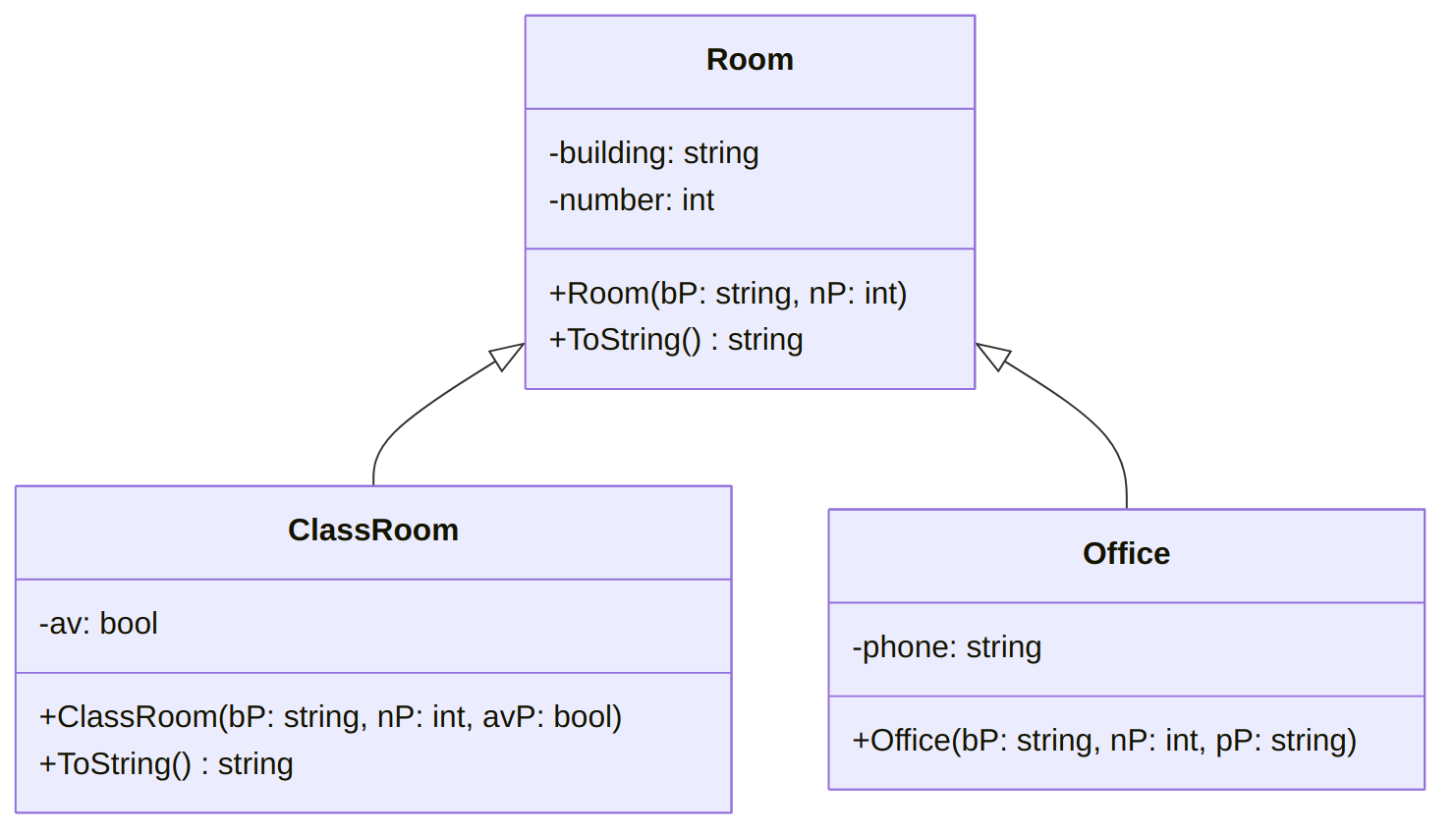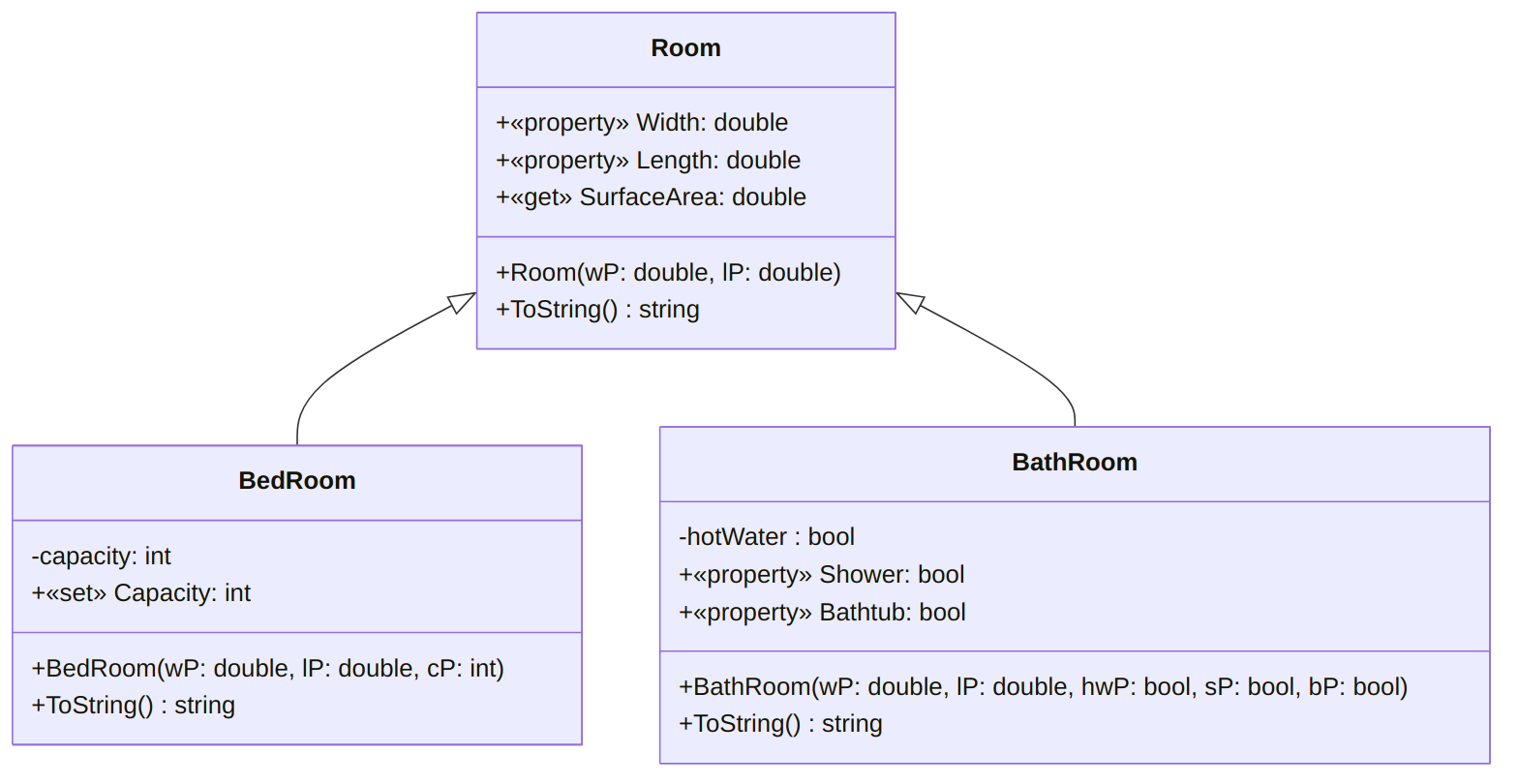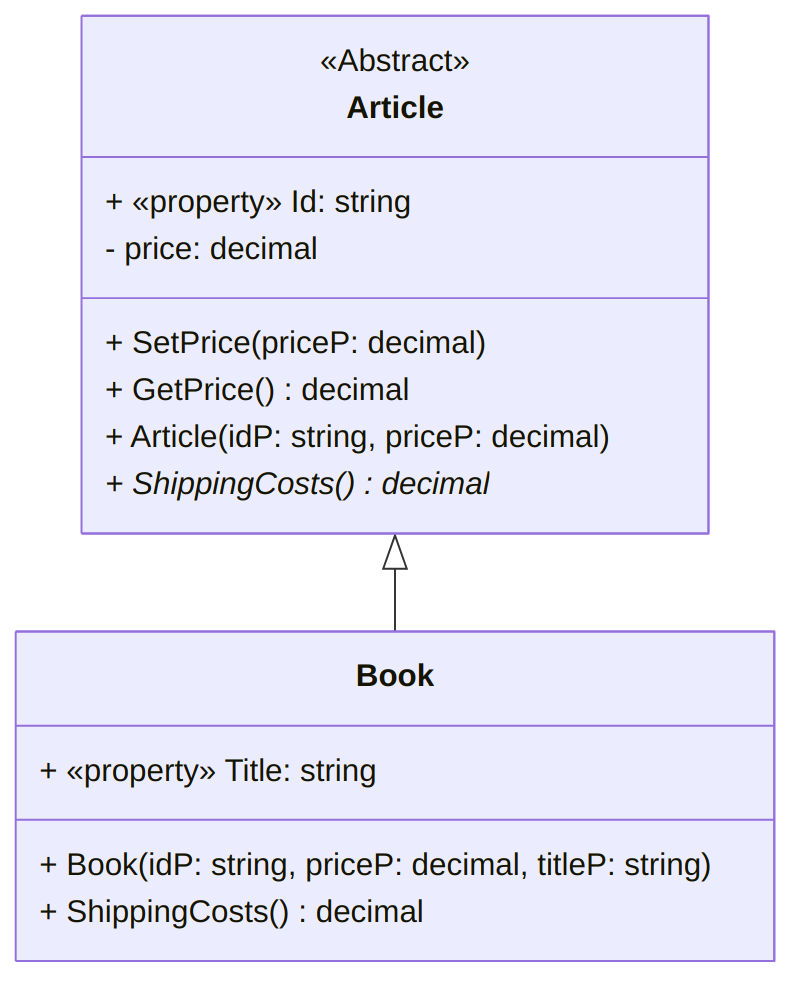Questions
-
What is the keyword used to call the constructor from the base class?
-
this. - the name of the base class.
-
base -
over -
inherits
-
-
Suppose your are given an
ElectricDeviceclass and aWallDecorclass. You would like to write aClockclass that represents at the same time an electric device and a wall decor. This is possible only if theElectricDeviceandWallDecorclasses are…- Sealed
- Interfaces
- Protected
- Constructors
-
A method with header
public virtual void Test(int a, out int b)will…- Return a value
- Set the value of
b - Require two arguments
- Be overrideable
-
A method with header
public abstract string Test()will…- Have an empty body
- Need to be inside an
abstractclass - Not be overriden
Problems
- Consider the diagram representing the “Room”, “ClassRoom”, “Office” classes and their relations.

Suppose you are given an implementation of the Room class, such that
Room test = new Room("UH", 243);
Console.WriteLine(test);displays
UH 243-
Write an implementation of the
ClassRoomclass. YourToStringmethod should display the room’s building and number, in addition to whether it has AV set-up.Solution
class ClassRoom : Room { private bool av; public ClassRoom(string bP, int nP, bool aP) : base(bP, nP) { av = aP; } public override string ToString() { return base.ToString() + "av? " + av; } } -
Write a
SameBuildingstatic method to be placed inside theRoomclass such thatOffice test1 = new Office("UH", 127, "706 737 1566"); ClassRoom test2 = new ClassRoom("UH", 243, true); Office test3 = new Office("AH", 122, "706 729 2416"); Console.WriteLine(Room.SameBuilding(test1, test2)); Console.WriteLine(Room.SameBuilding(test2, test3));Would display “true” and “false”.
Solution
public static bool SameBuilding(Room a, Room b) { return a.building == b.building; } -
Consider the diagram representing the “Room”, “BedRoom”, “BathRoom” classes and their relations.

-
Write an implementation of the
SurfaceAreaproperty for theRoomclass, assuming you are given an implementation of theWidthandLengthproperties. -
Check the statements that would compile, assuming that
rTestis aRoomobject,beTestis aBedRoomobject, andbaTestis aBathRoomobject.-
rTest.Capacity = 12; -
baTest.Width = 12; -
beTest.capacity = 3; -
rTest.SurfaceArea = -2; -
baTest.Capacity = 3; -
beTest.Shower = true; -
Console.WriteLine(baTest.ToString());
-
-
Write a complete implementation of the
BedRoomclass.- Your
Capacityproperty should use thecapacityattribute, and throw an exception if the argument given is strictly less than 1. - Your
ToStringmethod should complement theRoom’sToStringby appending to itsstringthe capacity (in person) of theBedRoomobject.
Solution
using System; class BedRoom : Room { private int capacity; public int Capacity { set { if (value < 0) { throw new ArgumentException( "A capacity must be positive or 0." ); } else { capacity = value; } } } public BedRoom(double wP, double lP, int cP) : base(wP, lP) { Capacity = cP; } public override string ToString() { return base.ToString() + "Capacity: " + capacity; } } - Your
-
Write the
ToStringmethod of theBathRoomclass, knowing that a disclaimer should be part of thestringreturned if theBathRoomhas a shower or a bathtub but no hot water.Solution
public override string ToString() { string equipement = ""; if (Shower) { equipement += "a shower"; } if (Shower && Bathtub) { equipement += " and "; } if (Bathtub) { equipement += "a bathtub"; } if (!Shower && !Bathtub) equipement += "no shower nor bathtub"; equipement += "."; if (!hotWater && (Shower || Bathtub)) { equipement += " However, it does not have hot water"; } return base.ToString() + "\nThis bathtub has " + equipement; }
-
-
Consider the diagram representing the “Article”, “Book” classes and their relations.

-
Write a (partial) implementation of the
Articleabstract class:- Write an implementation for the
priceattribute: you can either use a getter and a setter (as pictured in the UML diagram), or a property. However, in both cases, setting the price to a negative value should result in anArgumentOutOfRangeExceptionexception being thrown. - Write an abstract
ShippingCosts()method.
Solution
using System; abstract class Article { public string Id { get; set; } private decimal price; public void SetPrice(decimal priceP) { if (priceP < 0) { throw new ArgumentOutOfRangeException(); } else { price = priceP; } } public decimal GetPrice() { return price; } public Article(string idP, decimal priceP) { Id = idP; SetPrice(priceP); } public abstract decimal ShippingCosts(); } - Write an implementation for the
-
Now, assume given a complete implementation of the
Articleabstract class. Write a complete implementation of theBookclass (header included), containing:- An implementation of the
Titleproperty using auto-properties. - A
Bookconstructor that passes theidPandpriceParguments to theArticleconstructor. ThetitlePargument should be assigned to theTitleproperty. - A
ShippingCosts()method that returns either 5.0, or 10% of the Book’s price, whichever is smallest.
Solution
class Book : Article { public string Title { get; set; } public Book(string idP, decimal priceP, string titleP) : base(idP, priceP) { Title = titleP; } public override decimal ShippingCosts() { decimal tenp = .1M * GetPrice(); if (tenp > 5M) { tenp = 5M; } return tenp; } } - An implementation of the
-
Write statements that, if placed in a
Mainmethod, would- Create a
BookwithId“AAA001”,price$12.5, titled “What it’s like to be a bird”. - Display (nicely) its shipping costs.
- Display its
Id(as retrieved from the object).
Solution
using System; class Program { public static void Main() { Book test = new Book( "AAA001", 12.5M, "What it's like to be a bird." ); Console.WriteLine($"{test.ShippingCosts():C}"); Console.WriteLine(test.Id); } } - Create a
-